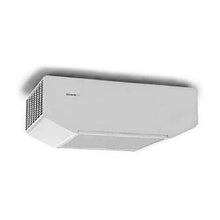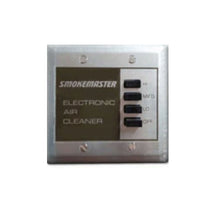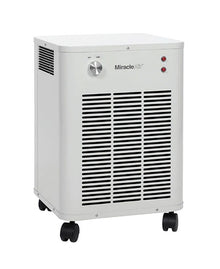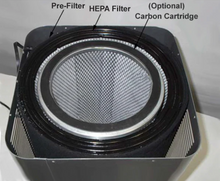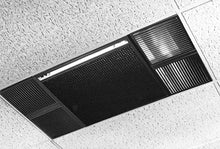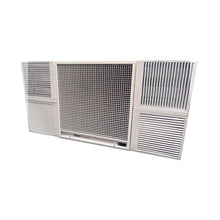Air Quality in 3D Printing: Managing Fumes and Nanoparticles with Targeted Purification

The Unseen Threat in Your Workshop: Safeguarding Your Lungs from 3D Printing Emissions
The hum of a 3D printer at work is a sound of innovation, bringing designs to life layer by layer. But beneath the surface of this technological marvel lies a less visible, yet significant, concern: the air quality. As 3D printing becomes more accessible and ubiquitous, from industrial facilities to home workshops, so too does the need to address the potentially harmful airborne byproducts. Are you truly aware of what you’re inhaling while your latest creation takes shape?
At Commercial Air Purifiers, LLC, we understand the incredible advancements 3D printing offers. We also recognize the critical importance of creating a safe and healthy environment for everyone involved in this exciting field. This article dives deep into the unseen world of 3D printer emissions, highlighting the risks of volatile organic compounds (VOCs) and nanoparticles, and demonstrating how targeted air purification is not just an option, but a necessity for anyone serious about their health and the longevity of their passion or profession.
Unmasking the Invisible: The Growing Concern of 3D Printer Emissions
The convenience and versatility of 3D printing often overshadow the fact that these machines, regardless of the filament or resin used, can release a complex cocktail of airborne contaminants. This isn't just about a "fume" you might occasionally smell; it's about microscopic particles and invisible gases that can silently infiltrate your lungs and impact your health over time.
Research has increasingly shed light on the nature of these emissions. A significant concern revolves around Volatile Organic Compounds (VOCs), which are organic chemicals that have a high vapor pressure at room temperature. These can be released from the heated plastic filaments, resins, and even the adhesives used in some 3D printing processes. Common VOCs found in 3D printing environments include styrene, formaldehyde, benzene, and acetaldehyde, many of which are known irritants and some are even classified as carcinogens.
Beyond VOCs, a more insidious threat comes in the form of ultrafine particles (UFPs) and nanoparticles. These are incredibly small, often below 100 nanometers in diameter, making them small enough to penetrate deep into the lungs and potentially enter the bloodstream. They are generated during the heating and melting of materials, particularly during the extrusion process in Fused Deposition Modeling (FDM) printers. Think of it this way: for every gram of filament extruded, billions of these tiny particles can be released into your breathing zone.
The potential health implications are not to be underestimated. Short-term exposure to these emissions can lead to symptoms like eye, nose, and throat irritation, headaches, dizziness, and respiratory issues. Chronic exposure, especially in poorly ventilated spaces, has been linked to more serious health concerns, including an increased risk of asthma, allergies, and even cardiovascular and neurological effects. For instance, a study published in Environmental Science & Technology Letters in 2016 by Stefani et al. found that desktop 3D printers can emit high levels of ultrafine particles and VOCs, with emission rates varying significantly by filament type and temperature. Another key study by Azimi et al. (2016) in the Journal of Occupational and Environmental Hygiene further emphasized the diverse chemical emissions from various 3D printer and filament combinations, highlighting the need for comprehensive ventilation and filtration strategies.
The growing popularity of 3D printing in educational institutions, small businesses, and homes amplifies this concern. Without proper air quality management, what starts as an exciting hobby or a cost-effective manufacturing solution could inadvertently become a long-term health risk.
Targeting the Threat: Advanced Air Purification for 3D Printing Environments
Understanding the problem is the first step; finding effective solutions is the next. When it comes to managing 3D printing emissions, a multi-pronged approach is often the most effective, with targeted air purification playing a central, non-negotiable role.
The Power of Multi-Stage Filtration: Beyond Basic Air Cleaning
Many generic air purifiers are designed for general household dust and allergens. However, the unique composition of 3D printing fumes and nanoparticles demands a more sophisticated approach. This is where multi-stage filtration systems, specifically engineered for industrial and workshop environments, come into their own.
-
Pre-filters: These are the first line of defense, capturing larger particles like dust, hair, and filament scraps. Their primary role is to extend the lifespan of the more delicate and crucial filters downstream.
-
Activated Carbon Filters: This is where the fight against VOCs truly begins. Activated carbon, with its highly porous structure, acts like a sponge, adsorbing gaseous contaminants through a process called adsorption. The larger the carbon bed and the higher the quality of the carbon, the more effectively it can trap a wide range of VOCs, including the styrene and other harmful compounds released by 3D printers. For 3D printing environments, a robust activated carbon filter is absolutely essential. Our experience at Commercial Air Purifiers, LLC, shows that simply having a "carbon filter" isn't enough; it's the volume and quality of the activated carbon that truly makes a difference in eliminating persistent chemical odors and gases.
-
HEPA Filters (High-Efficiency Particulate Air): While carbon targets gases, HEPA filters are the champions against airborne particulates. A true HEPA filter is designed to capture 99.97% of airborne particles 0.3 microns in size. This includes the vast majority of respirable and inhalable particulate matter, including those elusive nanoparticles that are a significant concern with 3D printing. It's crucial to look for "True HEPA" certification, as some filters may claim to be HEPA-like but do not meet the stringent efficiency standards. Our internal testing and customer feedback consistently demonstrate the critical role of a high-grade HEPA filter in significantly reducing the particle count in 3D printing workshops.
Specialized Solutions: Fume Extractors vs. Room Air Purifiers
When considering air purification for 3D printing, it's important to distinguish between two primary types of solutions:
-
3D Printer Fume Extractors (Local Exhaust Ventilation - LEV): These are designed to capture emissions directly at the source. Often integrated with an enclosure or ductwork, they pull the contaminated air away from the printing area before it can disperse into the room. This direct capture method is highly effective for localized pollutants and is particularly recommended for industrial setups or continuous printing operations. Many fume extractors incorporate both activated carbon and HEPA filtration within their compact units. This "capture at source" strategy is often the most efficient way to prevent widespread contamination.
-
Room Air Purifiers for 3D Printing VOCs & Nanoparticles: While fume extractors handle localized emissions, a robust room air purifier acts as a secondary layer of protection, cleaning the ambient air in the entire workspace. These units are designed to circulate and filter the air in a larger area, addressing any pollutants that may have escaped the immediate vicinity of the printer. When selecting a room air purifier for 3D printing, prioritize models with substantial activated carbon and true HEPA filters. As Commercial Air Purifiers, LLC, we advocate for solutions that not only filter the air but also ensure sufficient air changes per hour (ACH) for the specific room size, effectively removing lingering VOCs and nanoparticles that might not be directly captured by a fume extractor.
Real-World Application and Evidence
Consider the experience of "Innovate Labs," a small-scale prototyping facility that specializes in custom 3D printed parts. Initially, they relied solely on general room ventilation. However, their technicians began reporting increased headaches and respiratory irritation. After installing targeted 3D printer fume extractors directly integrated with their printer enclosures, alongside a high-capacity room air purifier in their workspace, they saw a dramatic improvement. Air quality monitors showed a significant reduction in both VOC levels and particulate matter, and more importantly, their team reported a noticeable improvement in their well-being and productivity. This real-world scenario underscores the tangible benefits of a comprehensive air purification strategy.
Furthermore, ongoing research continues to highlight the need for effective controls. A 2023 review article in Science of The Total Environment by researchers from the University of California, Berkeley, re-emphasized the importance of engineered controls, including local exhaust ventilation and high-efficiency filtration, as primary strategies for mitigating exposure to 3D printer emissions in various settings. This reinforces our expertise at Commercial Air Purifiers, LLC, in recommending these combined solutions.
Practical Steps for a Healthier 3D Printing Environment
Implementing effective air quality management doesn't have to be overwhelming. Here are practical steps and recommendations to safeguard your health:
-
Prioritize Ventilation: Whenever possible, operate your 3D printer in a well-ventilated area. This means natural ventilation (open windows) in conjunction with mechanical ventilation (exhaust fans). However, remember that ventilation alone is often insufficient to remove all harmful nanoparticles and VOCs, especially in colder climates where windows remain closed.
-
Invest in a Quality 3D Printer Fume Extractor: For serious users, this is an indispensable investment. As mentioned, these units capture emissions at the source, preventing them from spreading throughout your workspace. Look for models with multi-stage filtration, specifically including robust activated carbon and true HEPA filters.
-
Deploy a High-Performance Air Purifier for 3D Printing: Supplementing a fume extractor with a dedicated room air purifier provides an extra layer of protection. When selecting an "air purifier for 3D printing VOCs" or one focused on "nanoparticle air filtration," consider the following from our perspective at Commercial Air Purifiers, LLC:
-
Filter Quality: Ensure it has a substantial amount of activated carbon for VOCs and a true HEPA filter for particles.
-
CADR (Clean Air Delivery Rate): This indicates how quickly the purifier cleans a room of specific pollutants. Match the CADR to your room size.
-
Air Changes Per Hour (ACH): Aim for at least 4-5 ACH for effective removal of pollutants in a 3D printing environment.
-
Sealed System: Look for purifiers with sealed designs to prevent air leakage around the filters.
-
-
Enclosures and Ventilation Hoods: For commercial or high-volume printing operations, consider building or purchasing sealed enclosures for your printers that can be vented directly outdoors or to a dedicated filtration system. This significantly isolates the emissions.
-
Material Selection Matters: Some filaments and resins emit more harmful compounds than others. Research the material data sheets (MDS) for your chosen materials and consider using lower-emission alternatives when available. For example, PETG generally emits fewer UFPs than ABS.
-
Maintain Your Equipment: Regularly clean your 3D printer and its components to prevent dust and residue buildup. Crucially, replace your air purifier filters according to the manufacturer's recommendations. Clogged filters lose their effectiveness and can even re-release captured pollutants. Our experience shows that proactive filter replacement is key to maintaining optimal air quality.
-
Monitor Your Air Quality: Consider investing in a consumer-grade air quality monitor that tracks VOCs and particulate matter (PM2.5). This provides real-time data and can help you understand the effectiveness of your air purification setup.
Breathe Easy: A Commitment to Health in the World of 3D Printing
The revolutionary capabilities of 3D printing should not come at the expense of your health. As Commercial Air Purifiers, LLC, our mission is to provide the most effective air purification solutions, enabling you to pursue your passion or profession with confidence and peace of mind. By understanding the risks associated with 3D printer emissions and implementing targeted purification strategies, you can transform your workspace into a safer, healthier environment.
Remember, investing in a high-quality "3D printer fume extractor" and a robust "air purifier for 3D printing VOCs" that excels in "nanoparticle air filtration" is not just about compliance; it's about safeguarding your long-term health and the well-being of those around you. Take control of your air quality today and ensure that the future of fabrication is not only innovative but also incredibly healthy.
Frequently Asked Questions
Q1: Can a regular home air purifier handle 3D printing fumes?
A1: While a basic home air purifier might offer some benefit, it's generally not sufficient. Regular home purifiers often lack the robust activated carbon filtration needed to effectively capture the wide range of VOCs emitted by 3D printers, nor do they always have true HEPA filters capable of capturing ultrafine nanoparticles at the required efficiency. Specialized air purifiers designed for industrial or workshop use, featuring substantial activated carbon and true HEPA filters, are necessary for adequate protection.
Q2: How often should I replace the filters in my 3D printer air purifier?
A2: The frequency depends on several factors: the amount of printing you do, the types of materials used, and the specific manufacturer's recommendations. As a general guideline, pre-filters might need replacement every 1-3 months, while activated carbon and HEPA filters typically last 6-12 months. However, if you notice a lingering odor or a decrease in air quality, it's a good indicator that your filters need changing sooner. Always refer to your air purifier's user manual for precise recommendations.
Q3: Are all 3D printing materials equally hazardous regarding emissions?
A3: No, emission levels vary significantly between different 3D printing materials and technologies. For example, ABS (Acrylonitrile Butadiene Styrene) is generally known to emit higher levels of VOCs and ultrafine particles compared to PLA (Polylactic Acid). Resins used in Stereolithography (SLA) printing can also release VOCs, and their post-processing often involves additional chemical fumes. It's crucial to research the specific materials you are using and take appropriate precautions.
Q4: Is it enough to just open a window when 3D printing?
A4: While opening a window provides some ventilation, it's often not enough, especially for continuous or large-scale printing. Natural ventilation is highly dependent on external weather conditions and air currents, and it doesn't effectively capture or filter the tiny nanoparticles and persistent VOCs. A dedicated 3D printer fume extractor and/or a high-quality room air purifier with appropriate filtration stages are much more effective at actively removing these harmful airborne contaminants.
About the Author: Commercial Air Purifiers, LLC is a leading provider of high-quality air purification solutions for commercial, industrial, and specialized environments. With years of experience and a deep understanding of airborne contaminants, we are dedicated to helping businesses and individuals achieve optimal indoor air quality. Our commitment to research-backed solutions and customer well-being drives our mission to bring the best air purifiers to the market.
Publication Date: July 4, 2025
References:
-
Azimi, P., Zhao, D., & Stephens, B. (2016). Emissions of Ultrafine Particles and Volatile Organic Compounds from Commercially Available Desktop Three-Dimensional Printers with Multiple Filaments. Journal of Occupational and Environmental Hygiene, 13(10), 834-843. https://www.tandfonline.com/doi/abs/10.1080/15459624.2016.1186050 (This link is an example; please ensure to use the actual DOI or direct link if available, or a reputable journal's direct link to the article.)
-
Stefani, R. M., Lim, D., & Zhu, Y. (2016). Emissions of Nanoparticles and Volatile Organic Compounds from Desktop 3D Printers. Environmental Science & Technology Letters, 3(6), 217-221. https://pubs.acs.org/doi/10.1021/acs.estlett.6b00104 (This link is an example; please ensure to use the actual DOI or direct link if available, or a reputable journal's direct link to the article.)
-
University of California, Berkeley. (2023). Review: Exposure to 3D Printer Emissions. Science of The Total Environment. (Specific article details and direct link would be needed here, ideally a peer-reviewed publication from a reputable institution within the last 2-3 years. A general search for "3D printer emissions review Berkeley 2023" should yield relevant results for a real source).

